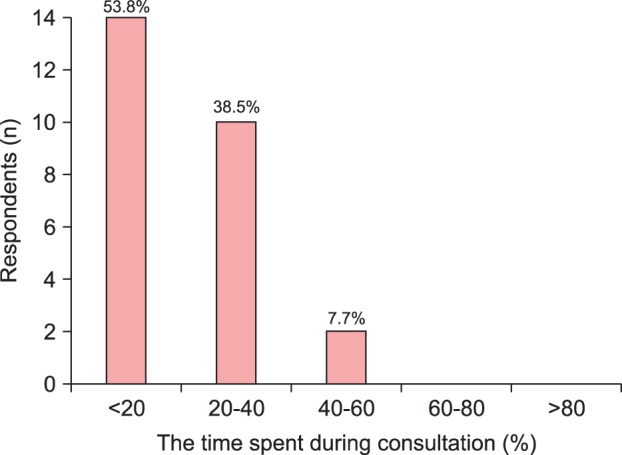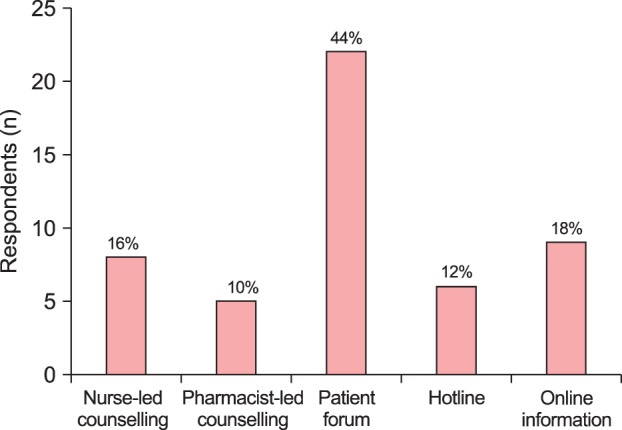Ann Dermatol.
2017 Oct;29(5):559-564. 10.5021/ad.2017.29.5.559.
Adherence to Topical Therapies for the Treatment of Psoriasis: Surveys of Physicians and Patients
- Affiliations
-
- 1Department of Dermatology, Seoul National University Bundang Hospital, Seoul National University College of Medicine, Seongnam, Korea. swyoun@snu.ac.kr
- KMID: 2388906
- DOI: http://doi.org/10.5021/ad.2017.29.5.559
Abstract
- BACKGROUND
There have been few studies of treatment adherence in Asian patients with psoriasis and understanding of the factors is important to improve outcomes.
OBJECTIVE
To provide an overview of treatment adherence among Korean patients with psoriasis and to understand how the perceptions of patients and physicians affect topical treatment adherence.
METHODS
A cross-sectional questionnaire survey was conducted to determine the views and opinions of dermatologists and psoriasis patients on topical treatment adherence. The survey items were developed in collaboration with psoriasis experts.
RESULTS
Twenty-six dermatologists and fifty patients completed their questionnaire. In the physician survey, more than half of dermatologists only inquired about adherence up to 20% of the time. Most dermatologists generally thought that their patients had high expectations of treatment. Nearly 40% of dermatologists reported that more than 60% of their patients adhered to the prescribed topical treatment. In the patient survey, more than 15% of patients reported that they did not receive enough information about the drug. Around one-fifth of the patients also complained about the physical properties of the products. The majority of patients were confident with the current topical treatments and expected fast improvement, within a couple of weeks. The most common reason for low adherence was forgetfulness. Inconvenience and concerns about side effects were common reasons for topical treatment discontinuation.
CONCLUSION
Because adherence to topical treatment is a complex, multifactorial issue with factors varying between patients, dermatologists should focus on determining each patient's individual adherence barriers to achieve good treatment outcomes.
Keyword
MeSH Terms
Figure
Reference
-
1. Osterberg L, Blaschke T. Adherence to medication. N Engl J Med. 2005; 353:487–497. PMID: 16079372.
Article2. Sabaté E. Adherence to long-term therapies: evidence for action. Geneva: World Health Organization;2003.3. Brown KK, Rehmus WE, Kimball AB. Determining the relative importance of patient motivations for nonadherence to topical corticosteroid therapy in psoriasis. J Am Acad Dermatol. 2006; 55:607–613. PMID: 17010739.
Article4. Fouéré S, Adjadj L, Pawin H. How patients experience psoriasis: results from a European survey. J Eur Acad Dermatol Venereol. 2005; 19(Suppl 3):2–6. PMID: 16274404.5. Devaux S, Castela A, Archier E, Gallini A, Joly P, Misery L, et al. Adherence to topical treatment in psoriasis: a systematic literature review. J Eur Acad Dermatol Venereol. 2012; 26(Suppl 3):61–67. PMID: 22512682.
Article6. Davis SA, Lin HC, Yu CH, Balkrishnan R, Feldman SR. Underuse of early follow-up visits: a missed opportunity to improve patients' adherence. J Drugs Dermatol. 2014; 13:833–836. PMID: 25007367.7. Bewley A, Burrage DM, Ersser SJ, Hansen M, Ward C. Identifying individual psychosocial and adherence support needs in patients with psoriasis: a multinational two-stage qualitative and quantitative study. J Eur Acad Dermatol Venereol. 2014; 28:763–770. PMID: 23663069.
Article8. Chang YT, Chen TJ, Liu PC, Chen YC, Chen YJ, Huang YL, et al. Epidemiological study of psoriasis in the national health insurance database in Taiwan. Acta Derm Venereol. 2009; 89:262–266. PMID: 19479122.
Article9. Tsai TF, Wang TS, Hung ST, Tsai PI, Schenkel B, Zhang M, et al. Epidemiology and comorbidities of psoriasis patients in a national database in Taiwan. J Dermatol Sci. 2011; 63:40–46. PMID: 21543188.
Article10. Yip SY. The prevalence of psoriasis in the Mongoloid race. J Am Acad Dermatol. 1984; 10:965–968. PMID: 6736341.
Article11. Torrelo A, Ortiz J, Alomar A, Ros S, Pedrosa E, Cuervo J. Health-related quality of life, patient satisfaction, and adherence to treatment in patients with moderate or severe atopic dermatitis on maintenance therapy: the CONDA-SAT study. Actas Dermosifiliogr. 2013; 104:409–417. PMID: 23665434.
Article12. Conlon NP, Edgar JD. Adherence to best practice guidelines in chronic spontaneous urticaria (CSU) improves patient outcome. Eur J Dermatol. 2014; 24:385–386. PMID: 24682625.
Article13. Snyder S, Crandell I, Davis SA, Feldman SR. Medical adherence to acne therapy: a systematic review. Am J Clin Dermatol. 2014; 15:87–94. PMID: 24481999.
Article14. Zschocke I, Mrowietz U, Karakasili E, Reich K. Non-adherence and measures to improve adherence in the topical treatment of psoriasis. J Eur Acad Dermatol Venereol. 2014; 28(Suppl 2):4–9. PMID: 24684738.
Article15. Rapp SR, Exum ML, Reboussin DM, Feldman SR, Fleischer A, Clark A. The physical, psychological and social impact of psoriasis. J Health Psychol. 1997; 2:525–537. PMID: 22013093.
Article16. Richards HL, Fortune DG, O'Sullivan TM, Main CJ, Griffiths CE. Patients with psoriasis and their compliance with medication. J Am Acad Dermatol. 1999; 41:581–583. PMID: 10495380.
Article17. Lee JY, Her Y, Kim CW, Kim SS. Topical corticosteroid phobia among parents of children with atopic eczema in Korea. Ann Dermatol. 2015; 27:499–506. PMID: 26512163.
Article18. Charman CR, Morris AD, Williams HC. Topical corticosteroid phobia in patients with atopic eczema. Br J Dermatol. 2000; 142:931–936. PMID: 10809850.
Article19. Feldman SR, Horn EJ, Balkrishnan R, Basra MK, Finlay AY, McCoy D, et al. Psoriasis: improving adherence to topical therapy. J Am Acad Dermatol. 2008; 59:1009–1016. PMID: 18835062.
Article20. Poyner TF, Menday AP, Williams ZV. Patient attitudes to topical antipsoriatic treatment with calcipotriol and dithranol. J Eur Acad Dermatol Venereol. 2000; 14:153–158. PMID: 11032056.
Article
- Full Text Links
- Actions
-
Cited
- CITED
-
- Close
- Share
- Similar articles
-
- Treatment of Psoriasis
- Comparative Study of Quality of Life in Patients with Scalp Psoriasis Treated Using Topical Steroid Alone vs. Topical Steroid Combined with Cyclosporine
- Infliximab: Effective Therapy for Pustular Psoriasis
- A Case of Recalcitrant Psoriasis Improved with Tacrolimus (FK 506)
- Psoriasis flares after COVID-19 vaccination: adherence to biologic therapy reduces psoriasis exacerbations: a case-control study




